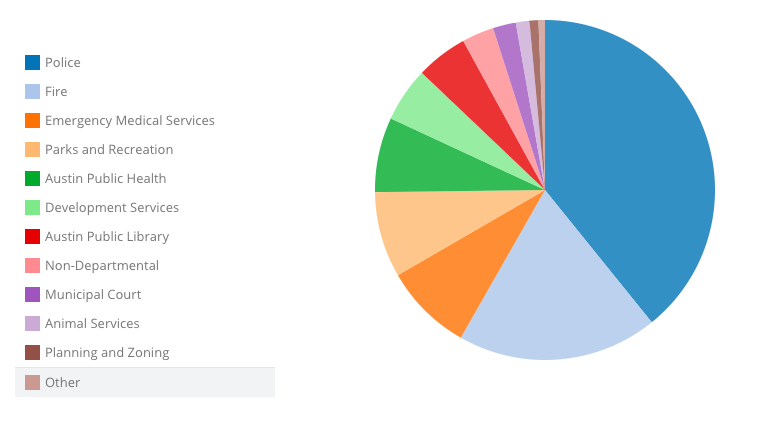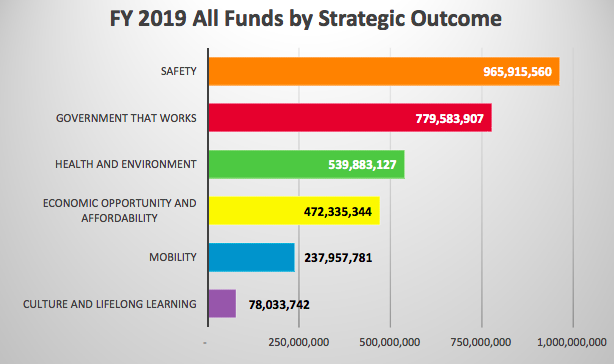Here at the Austin EcoNetwork, we love to show you the many ways that local government affects your life… and teach you how to get involved with these issues and make a difference in your local community.
There is perhaps no clearer example of the impact of government than the city’s budget. Every year in the late summer, Austin City Council makes some big decisions. They decide how much our property tax bills will rise or fall. They decide how much public money will be spent on building affordable housing in this city. They decide if our parks will have enough funding to provide us with fun, recreational opportunities for years to come.
Yes, we know that the idea of a bunch of numbers on a page can seem a bit boring. But that’s not all a budget is. Simply put, a budget is how a city spends all of our money… which means that this is a conversation you simply don’t want to miss out on.
Never participated in the city’s budget process before? Don’t worry, we’ll teach you everything you need to know.
1. The Basics
Earlier this week, Austin’s new city manager, Spencer Cronk, delivered his proposal for the city’s new 2018-2019 budget.
Here’s what’s in it:
- $4.1 billion all-funds budget (This includes city departments that generate their own revenue, like Austin Energy and Austin Water.) This is a 4 percent increase from last year.
- $1 billion General Fund budget (This is where the bulk of the city’s discretionary spending comes into play, which means it often gets the most attention during budget talks.) This is a $600,000 increase from last year.
- 4.9 percent property tax increase – For the average Austinite (with a home worth $332,366) this amounts to an addition $78.04 in property taxes and fees this upcoming year. Although the average Austinite will be paying more in property taxes this year, it’s a smaller increase than we’ve seen in recent years. For example, last year, the average Austinite’s property tax bill increased by $151
- Homestead exemption increases from 8 percent to 10 percent (which means you can exempt 10 percent of your home’s value from property taxes)
2. A New Budgeting Process For Austin
In his first budget cycle as city manager, Cronk has introduced a new way of doing things. Instead of presenting the budget as chunks of money going toward different city departments (see last year’s budget chart below), Cronk has decided to break things up into the desired outcomes that our budget spending could bring us.
These so-called “Strategic Outcomes” were adopted by City Council and include:
- Health & Environment
- Culture & Lifelong Learning
- Economic Opportunity & Affordability
- Government That Works
- Mobility
- Safety
In April, Council got even more specific about these outcomes, prioritizing 10 “indicators of success,” aka areas where the city most needs to improve over the next two to three years.
These priorities are:
And here is how the money is allocated across each of these outcomes in the proposed budget:
The exact breakdown of how all of this money will be spent is included in this document.
Not surprisingly, it’s a bit long, so we’ve taken the time to pull out some of the highlights for you:
- Fully funding the Housing Trust Fund (which supports affordable housing) for the first time ever, allocating a total of $5.3 million towards it
- $500,000 for the implementation of the Strategic Housing Blueprint (which creates goals to maintain affordable housing in this city), community land trust technical assistance, and homeowner educational campaign
- $3.1 million of new funding for homelessness programs, including $1 million and 5 positions to enhance the Homelessness Outreach Street Team program (which helps homeless people get the resources they need)
- Two new fire stations at Moore’s Crossing and Travis Country
- $5.7 million for 33 new police officers and equipment, bringing the total number of officers to 1,929
- $119,000 for 2 new victim services counselors, which brings total program staffing to 29 positions
- $800,000 for the Vision Zero program, which seeks to eliminate traffic deaths in Austin
- $400,000 for the Art Space Assistant Program to help displaced nonprofit arts groups
- $611,000 increase and 5 positions for parks grounds, facilities, and playground maintenance
- $307,000 investment in the urban forestry program, bringing total program funding to $2.9 million
- $200,000 to conduct a Lesbian, Gay, Bisexual, Transgender, and Queer quality-of-life community study
- Increase of $257,000 for an Equity Academy to support rollout of the annual Equity Assessment Tool
- For the first time ever, all city employees (including seasonal and temporary) will make a living wage of $15 an hour
- $300,000 for immigrant legal services to help immigrants and refugees understand their rights and get the legal help that they may need
3. What Comes Next? And How Can You Get Involved
The city’s new budget cycle begins on October 1st, so a formal budget must be passed by City Council before then.
It’s also important to remember that the city manager’s budget proposal is just that… a proposal. Now, it’s City Council’s turn to take a whack at it, hear from the community, and edit it accordingly. City Council will host two work sessions (where they’ll debate and discuss the budget) on August 15th and 29th. Public hearings on the budget will be held August 22nd and August 30th. The budget is expected to be adopted in early September.
So what will the debates likely focus around? For starters, Council could still decide to slightly raise the property tax increase (about what Cronk suggested) in order to fund more programs. If this happens, there will surely be debate about where this money should be spent or if taxes should be raised at all.
In recent budget cycles, much debate has also focused around the amount of money that goes toward the police department, with some in the community asking for less money to be spent on policing and more on programs that prevent crime in the first place.
If you’d like to participate in the city’s budget process, there are several ways you can get involved:
- You can educate yourself more about the city’s budget process by attending “Budget Party 2018,” hosted by Glasshouse Policy, the Austin Monitor, and the Austin Tech Alliance. The event is on Tuesday, August 14th from 5:30pm to 8pm at the Capital Factory. You can RSVP here.
- You can attend one of the budget public hearings and sign up to speak (stay tuned for exact start times, etc)
- You can email your City Council member with your own thoughts/opinions about the city’s budget
- Keep reading the Austin EcoNetwork, because we’ll keep you up-to-date on any changes to the budget, as well as additional opportunities to get involved






